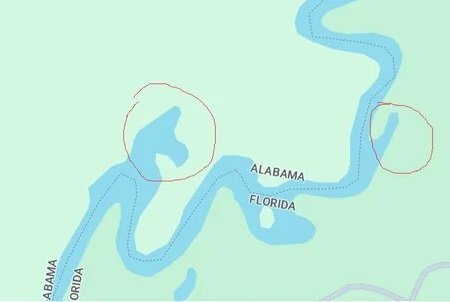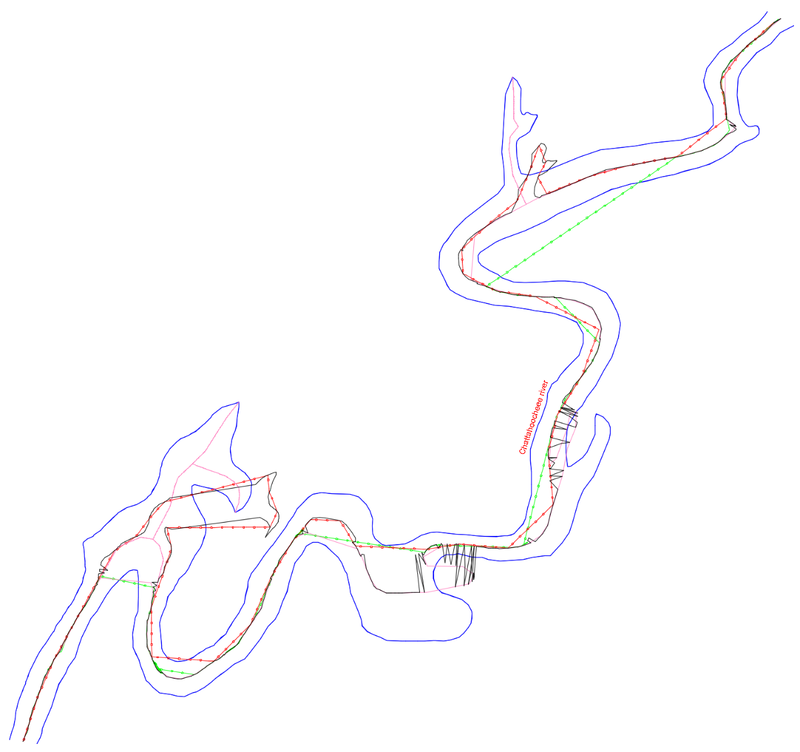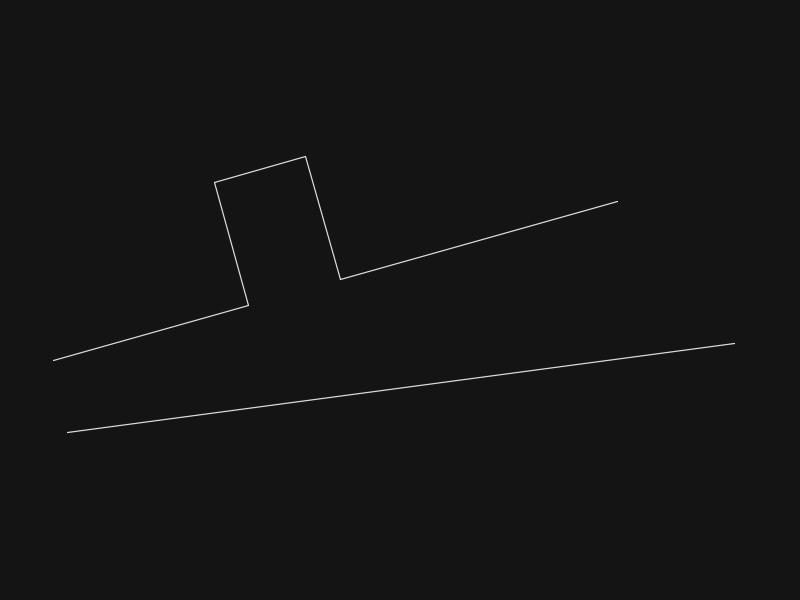Leaderboard
Popular Content
Showing content with the highest reputation since 12/19/2025 in Posts
-
Attempt number 2: This code is intended to always return a centerline whose points are all perfectly equidistant from the margins. This should happen in all cases where two LWPOLYLINEs are provided, one for each margin. The case of islands has not been considered yet. The resulting centerline is geometrically dense. This can probably be simplified in a future version. The approach taken in this code has been to obtain points from the normals and the bisectors of each margin, which are then combined at the end to build a list of points. Therefore, it is a fragmentary and massive approach. For this reason, the code is not very fast. However, there is another, more elegant approach, based on dynamically relating the geometry of both margins. It is more complex, but it would also be faster, and the error margins would be “bridgable”. If this thread has enough life in it, I may feel sufficiently motivated to finish it. That’s all for now. ;|*********************** CENTER-LINE ************************* ************************ G L A V C V S ************************* ************************** F E C I T *************************** |; (defun c:CLG (/ PI/2 lst e1 e2 l1 l2 lp lp1 lp2 p0 p> p< r1? x m a tol autoInt? ordenaPts interCpta ptEqd) (defun autoInt? (l lp / p0 p1 p2);autointersecci贸n? (if l (setq p1 (polar (car l) (setq a (angle (car l) (cadr l))) 0.001) p2 (polar (cadr l) (+ a PI) 0.001) x (if (not (vl-some '(lambda (p) (if p0 (inters p0 (setq p0 p) p1 p2) (not (setq p0 p)))) lp)) l) ) ) ) (defun ordenaPts (lst / pIni dm d ps? ps lr); puntos en orden (setq pIni (mapcar '(lambda (a b) (/ (+ a b) 2.0)) (car lp1) (car lp2))) (while lst (foreach p lst (if (and dm (/= (min (setq d (distance (if ps ps pIni) p)) dm) dm)) (setq dm d ps? p) (if (not dm) (setq dm (distance (if ps ps pIni) p) ps? p)) ) ) (setq ps ps? ps? nil dm nil lst (vl-remove ps lst) lr (cons (cadr ps) (cons (car ps) lr))) ) lr ) (defun interCpta (pM p1 p2 lp / i? i1 i2 d a b); captura de los m谩rgenes (defun i? (pA pB lp / p0 i dm is a) (foreach p lp (if p0 (if (setq i (inters p0 (setq p0 p) pA pB)) (if (and dm (/= (min (setq d (distance pM i)) dm) dm)) (setq dm d is i) (if (not dm) (setq dm (distance pm i) is i)) ) ) ) (setq p0 p) ) (if is (list (car is) (cadr is) 0.0)) ) (if (and (setq a (i? p1 p2 lp1)) (setq b (i? p1 p2 lp2))) (list a b) ) ) (defun ptEqd (A B e1 e2 / eqDist-f t0 t1 f0 f1 tm fm n i v+- v*); captura punto equidistante (defun v+- (o a b) (mapcar o a b)) (defun v* (p s) (mapcar '(lambda (x) (* x s)) p)) (defun eqDist-f (ds A B e1 e2 / pt d1 d2) (setq pt (v+- '+ A (v* (v+- '- B A) ds)); Punto sobre AB: P(ds) = A + ds (B - A) d1 (distance pt (vlax-curve-getClosestPointTo e1 pt)) d2 (distance pt (vlax-curve-getClosestPointTo e2 pt)) ) (- d1 d2) ) (setq t0 0.0 t1 1.0) (while (and (< (setq n (if n (1+ n) 0)) 100) (> (- t1 t0) 1e-6));m茅todo de bisecci贸n (setq tm (/ (+ t0 t1) 2.0) fm (eqDist-f tm A B e1 e2) ) (if (< (abs fm) 1e-9) (setq n 100 t1 tm t0 tm) (if (< (* (if f0 f0 (eqDist-f t0 A B e1 e2)) fm) 0.0) (setq t1 tm f1 fm) (setq t0 tm f0 fm) ) ) ) (if (< t1 1.0) ; par谩metro final y punto equidistante (v+- '+ A (v* (v+- '- B A) (/ (+ t0 t1) 2.0))) ) ) (if (and (setq e1 (car (entsel "\nSelect FIRST LWPolyline..."))) (= (cdr (assoc 0 (setq l1 (entget e1)))) "LWPOLYLINE") ) (if (and (setq e2 (car (entsel "\nSelect SECOND LWPolyline..."))) (= (cdr (assoc 0 (setq l2 (entget e2)))) "LWPOLYLINE") ) (progn (foreach l l1 (if (= (car l) 10) (setq lp1 (cons (cdr l) lp1)))) (foreach l l2 (if (= (car l) 10) (setq lp2 (cons (cdr l) lp2)))) (setq r1? (> (distance (car lp1) (car lp2)) (distance (car lp1) (last lp2)))) (setq tol 0.01 PI/2 (/ PI 2.) lp1 (if r1? (reverse lp1) lp1)) (foreach e (list e1 e2) (setq p0 nil m nil r? (if (equal e e1) r1?) lp (if (equal e e1) lp2 lp1)) (while (setq p (vlax-curve-getPointAtParam e (setq m (if m ((if r? 1- 1+) m) (if r? (vlax-curve-getEndParam e) 0))))) (if p0 (progn (setq lAB (autoInt? (interCpta p (polar p (setq a (+ (angle p0 p) PI/2)) 10000) (polar p (+ a PI) 10000) lp) (if (equal e e1) lp1 lp2));NORMAL AL COMIENZO DEL SEGMENTO lst (if lAB (cons (ptEqd (car lAB) (cadr lAB) e1 e2) lst) lst) ) (if (setq p> (vlax-curve-getPointAtParam e ((if r? 1- 1+) m))) (setq lAB (autoInt? (interCpta p (polar p (setq a (/ (+ (angle p p0) (angle p p>)) 2.)) 10000) (polar p (+ a PI) 10000) lp) (if (equal e e1) lp1 lp2)) ; Bisectriz lst (if lAB (cons (ptEqd (car lAB) (cadr lAB) e1 e2) lst) lst) lAB (autoInt? (interCpta p (polar p (setq a (+ (angle p p>) PI/2)) 10000) (polar p (+ a PI) 10000) lp) (if (equal e e1) lp1 lp2));NORMAL AL FINAL DEL SEGMENTO lst (if lAB (cons (ptEqd (car lAB) (cadr lAB) e1 e2) lst) lst) ) ) (setq p< p0 p0 p) ) (if (setq p> (vlax-curve-getPointAtParam e ((if r? 1- 1+) m))) (setq lAB (autoInt? (interCpta p (polar (setq p0 p) (setq a (+ (angle p0 p>) PI/2)) 10000) (polar p0 (+ a PI) 10000) lp) (if (equal e e1) lp1 lp2)) lst (if lAB (cons (ptEqd (car lAB) (cadr lAB) e1 e2) lst) lst) ) ) ) ) ) (vla-AddLightWeightPolyline (vla-get-modelspace (vla-get-activedocument (vlax-get-acad-object))) (vlax-Make-Variant (vlax-SafeArray-Fill (vlax-Make-SafeArray 5 (cons 0 (- (length (setq lst (reverse (ordenaPts lst)))) 1))) lst)) ) ) ) ) (princ) )2 points
-
Need more information. What exactly are you doing, step by step? Do you have MAP 3D?1 point
-
What you'll probably need to do is set the proper coordinate system in your viewport. To make things simpler, you can create the proper view with UCS, give it a name, and save it. That way you can use it as many times as you need to. To prepare your plan, go to paper space, open the viewport, and "restore" the view. Once you have your linework at the right scale, angle, and location, lock the viewport. If your model is not supposed to look like a wireframe, check the properties for the Visual Style while in model space. If this doesn't help, please give us more information.1 point
-
(vl-catch-all-apply) is used to catch the error when the user presses Esc during the selection prompt, ensuring NOMUTT is set back to 0.1 point
-
I know this is an old thread but here it is my fifty cents attempt, I was looking for a created solution but had to complete it, thanks to all ;;; By Isaac A. 20251219 ;;; https://www.cadtutor.net/forum/topic/73414-select-all-points-on-polyline/ ;;; Point on Polyline 'ptopl' (vl-load-com) (defun c:ptopl (/ a b c d dw l oc os) (vla-startundomark (setq dw (vla-get-activedocument (vlax-get-acad-object)))) (setq oc (getvar 'cmdecho) os (getvar 'osmode) ) (setvar 'cmdecho 0) (setvar 'osmode 0) (princ "\nSelect the polylines that touch the points") (setq l (ssget (list (cons 0 "LWPOLYLINE")))) (if l (progn (setq a 0 ) (while (< a (sslength l)) (setq b (entget (ssname l a)) c (append c (mapcar 'cdr (vl-remove-if-not '(lambda (x) (= (car x) 10)) b))) a (1+ a) ) (setq d (ssget "F" c (list (cons 0 "Point")))) (sssetfirst nil d) ) ) (princ "\nThere are no selected polylines") ) (setvar 'cmdecho oc) (setvar 'osmode os) (vla-endundomark dw) (princ) ) ;;; End ptopl1 point
-
To test my memory, I opened the default drawing, created a new scale 1:1, and drew a couple of objects and a dimension. I made the dimension annotative and gave it the 1:1 scale. I copied those objects to the clipboard. Then I opened a second new drawing, which had our template settings, including a 1:1 scale. I pasted the objects from the clipboard into the second drawing. You'll never guess what happened. The pasted dimension had a scale of 1:1_1. In other words, that's the type of name AutoCAD gives a duplicate scale when it doesn't want you to rename an arbitrarily large group of settings. Does that shed any light on the issue?1 point
-
I am like others as suggested dont use a command word, as your wanting to use a defun then why not just call the defun something shorter, like CENTL.You can use AUTOLOAD to load the actual lisp at the first time you type centl. You would put the "Autoload" in say a custom lisp that is loaded on startup, along with your other AUTOLOAD's (autoload "CENTL" '("CENTL")) (autoload "COPY0" '("COPY0")) (autoload "COPYCOMMAND" '("ZZZ")) (autoload "COVER" '("COVER"))1 point
-
Are you using AutoCAD 2010? Along with previous suggestions and to add, you can do a lot of cleaning with the WBLOCK @ReMark, best method for true cleaning is to WBLOCK just the selected/visible objects you need, that way some of the things mentioned by @CyberAngel are hopefully not carried to the new drawing. I always start with -EXPORTTOAUTOCAD to clean up objects left by verticals, etc.1 point
-
One I can think of is to WBLOCK the entire drawing out to a new file name (temporarily) then compare the file sizes.1 point
-
How is "1:1_1" different from "1:1"? Is it possible there's a duplicate scale?1 point
-
1 point
-
I think the real-world situation may be more complex than what we’ve seen here so far. I took a look at the links that @SLW210 attached and decided to test the Lisp codes proposed up to this point. I looked through my drawings for something that could serve as an example for this problem, but it was like looking for a needle in a haystack. So, in the end, I decided to look for something in the real world that clearly corresponds to this issue — something like this: So I drew those margins and tested all the codes that have appeared in this thread so far. The result was… this! In the drawing, you can see the ones that managed to reach the end. However, the codes by BIGAL, GP_, GLAVCVS, and MarkoRibar couldn't even do that. Here’s the drawing AxisExple4.dwg1 point
-
Nice test @PGia, thanks! For some reason I didnt consider closed polylines in the _checkOffset function, so I added an extra check there. Should work as expected now: Not sure about the short corner. The lines are so narrow the centerline is pushed back out of the point. Seems to be logical to me but it does feel intuitive. Narrow indents don't get much love from the centerline. So "inlets" don't have enough influence on the shape of the line. What would the expected result be? Below makes sense since there is not enough space to go into the indent. Or are you maybe something like this where the line splits and goes into the hole:1 point
-
if you just want to go up and down use Ctrl+Pgdn, Ctrl+Pgup. This will let you jump to any layout. Goto-layout.lsp1 point
-
One option is to xref both drawings into a third, plotting only, drawing. You can then control the layer states, transparency, and draw order of both without affecting the originals. A similar option is to create two viewports, one for each plan. You can change the transparency of the layer your xref is on, and the viewport will inherit it. You still have the option to change layer states and draw order.1 point
-
Another: (defun c:foo (/ n p s) (if (setq s (ssget '((0 . "LWPOLYLINE")))) (foreach e (vl-remove-if 'listp (mapcar 'cadr (ssnamex s))) (setq n 0) (while (setq p (vlax-curve-getpointatparam e n)) (entmakex (list '(0 . "POINT") (cons 10 p))) (setq n (+ n 0.5)) ) ) ) (princ) )1 point
-
gsksun4 - It allows you to maximize the viewport. This gives you a model space view while working in a viewport. The advantage of working in this mode is the ability to work in model space with all the layers frozen in the viewport. You can double click outside the "red rope" to minimize the view.1 point
-
Just curious, why don't you scale and lock your viewport while you are inside the viewport? Select the scale from the viewport scale list on the status bar and then click on the padlock.1 point










